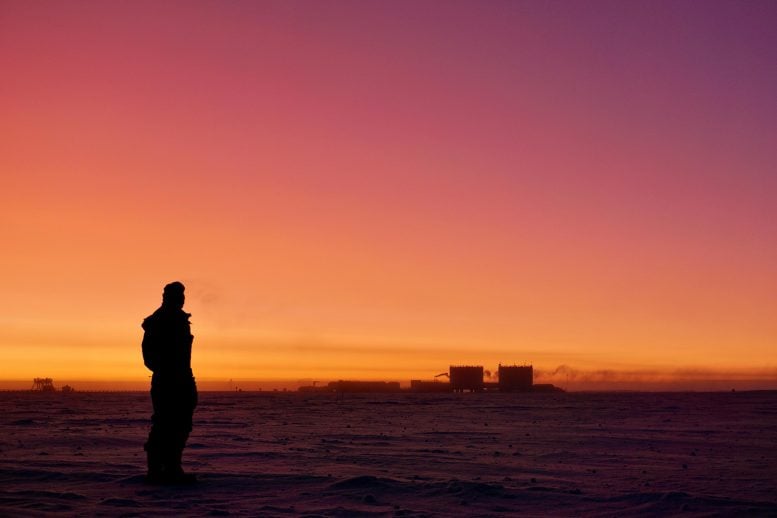20 Years of Ice-Cold Research: 7 Extremophile Tips for Healthy Living
ESA’s research medical doctor in Antarctica protected against the freezing conditions outside the French-Italian research base Concordia. Credit: ESA/IPEV/PNRA–S. Thoolen

This year marks two decades since the first ESA doctor set foot in Antarctica, running research at one of the most extreme places on Earth in preparation to explore far beyond it.
The crew of Italian-French research station, Concordia, in Antarctica, are subjected to almost nine months of complete isolation per year.
The station’s location, at 3233 m altitude, means inhabitants also experience chronic hypobaric hypoxia – lack of oxygen to the brain – making it an ideal environment to better understand how humans adapt and survive in extreme conditions.
During the Antarctic winter, the crew of up to 15 people also endure four months of complete darkness: the sun disappears from May and is not seen again until late August. Temperatures can drop to –80°C in the winter, with a yearly average of –50°C.
After reviewing 20 years of space research on Earth, researchers have established sound knowledge on this topic. Some of the tips below will come as no surprise, but solidifying this research is what helps space agencies choose astronauts who will explore farther, and achieve their mission – whether that is on the Moon, Mars or elsewhere.
- Exercise is important
One study divided the team into two groups. They asked one group to follow an exercise regime and the other to do little activity. The active group experienced a steady mood, while the “lazy” group showed more mood swings. - Practice to keep those skills fresh
Traveling in a spaceship to Mars takes nine months, will a martian astronaut be able to pilot their spacecraft to a safe landing without being able to practice for all that time? One crew in Concordia was trained to dock the Soyuz spacecraft to the International Space Station on actual training hardware. The crew was again divided into two. One group practised regularly and the others were only asked to dock in simulation at the end of their stay – no surprise, practice does help to ensure you keep your skills. - Blue light keeps you alert
Now a standard feature on modern computers and phones, you can set a ‘night light’ or red filter to dilute colour of the screen to stop you from staying awake. But does it really work? Research in Concordia has shown that blue light during the four months of darkness does keep the crew awake and more alert. This can be a good thing if you need to do a critical task, but conversely it is better to filter it out if you want a good night’s rest. - Lack of oxygen is not good for sleep
Insomnia plagues Concordians, and research has shown that part of the problem is sleep apnea, whereby breaths are skipped and less oxygen is inhaled. Mission designers need to keep this in account for future spacecraft that would preferably be built with less atmospheric pressure, like a jumbo jet. The results from this study are also significant for people who suffer from sleep apnea at home. - Get regular sleep
Sleep is good, but regular sleep is even better. Concordians who forced themselves to go to bed at fixed times even during four months without sunlight by following researchers’ schedules performed better, and felt better, than team members who went to bed when they felt like it. It is not called the Circadian rhythm for nothing. - Believe in yourself
People who feel they have the resources to cope with the extreme environment in Antarctica before they leave, show a quicker recovery to the thin air and humidity on site. Research showed that more positive people, before even setting foot in Antarctica, adapted better physically to the extreme environment. - Sunlight is best
Over time your eyes become more sensitive without sunlight and sleep is affected. These results suggest that during long-term daylight deprivation, retinal sensitivity to blue light increases, whereas circadian rhythm stability decreases and sleep–wake timing is delayed.
“Most of these tips should not come as a surprise, but this recap of 20 years of research and the research behind the tips above were ground-breaking at the time, they have now become common knowledge,” says Jennifer Ngo-Anh, research coordinator for ESA’s human and robotic exploration.
“It is important to have scientific justification behind our strategy for selecting and training astronauts as we design and prepare for missions farther into our Solar System,” continues Jennifer, “also there are always surprises whereby diligent research has shown the opposite of what was expected.”
Traveling on long-haul flights has long been associated with deep vein thrombosis, or blood clots in the legs. The lower air pressure coupled with little movement sitting in aircraft seats were logical factors to blame, but research on the crew at Concordia showed, surprisingly, that the lower air pressure did not seem to have an effect.
“Science is about showing new, unexpected correlations, but also proving what is generally well accepted. Here’s to 20 years of science in Antarctica and many more to come,” concludes Jennifer.
First supplies in nine months land at Concordia research station.














